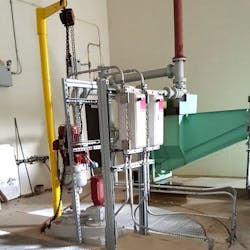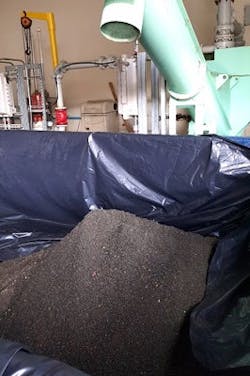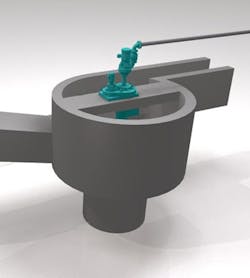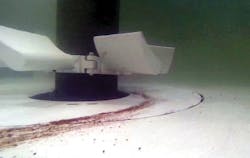Advanced Hydraulic Grit Removal Helps Resolve Plant’s Combined Sewer Challenges
The Shamokin Coal Township (Pa.) Joint Sewer Authority’s 2015 treatment plant upgrade and expansion, designed by Great Valley Consultants, centered on two primary goals: long-term control to mitigate overflows emanating from combined sewers and enhanced biological treatment capability. The project also expanded capacity from 7 mgd to 8.5 mgd average daily flows and peak flow conditions from 9 mgd to 13 mgd.
The Challenge
Adding sequencing batch reactors to the authority’s existing trickling filters allows the plant to achieve nutrient reduction and further lessen its eventual impact on the Chesapeake. In order to deal with the surge events and further protect the new downstream process equipment, the design team from Great Valley Consultants focused on augmenting plant head works infrastructure.
Incoming grit historically caused problems at the plant. Wet weather surges could overwhelm the older grit scheme, which consisted of an Archimedes screw device that auguered grit from two separate grit chamber wells. The composition of grit entering the collection system during sewer overflow events includes sediment and other forms of very fine grit particles that can be damaging to downstream equipment.
According to the sewer authority’s General Manager Paul Petrovich, the outmoded grit system was unable to keep up, and it necessitated costly maintenance to clear the accumulated grit four times each year. Even though the sewer authority could utilize its own vacuum trucks, the quarterly cleanouts still took two days with multiple personnel.
“It was very labor intensive,” Petrovich said.
The older system was not equipped to meet the wide variety of grit loads inherent in the combined sewers located in this coal-heavy region, including the finer grit particles that were depositing downstream in the plant. So the design team undertook a thorough evaluation of various grit removal technologies that would accomplish fine grit removal while maintaining effective performance during the surge events. With funding coming from varied state and federal sources, the selection of a successful grit system became more complex and, with the historical infiltration, more essential.
The Solution
Designers visited other treatment plants, and conducted meetings with various operators and equipment suppliers. The variety of approaches, combined with fine screening being added to the head works scheme, presented several different potential design scenarios and channel configurations. The designers ultimately specified hydraulic forced vortex technology because of the high grit removal efficiencies that could be achieved with minimal long-term cost.
The specified system was a complete Pista 360 grit removal system with integral hydraulic velocity control technology and grit-handling and dewatering components. Unlike conventional vortex-type systems, the Pista 360 grit removal system with V-Force Baffle maintains ideal velocity during low-flow and high-flow periods, ensuring consistent grit capture. Its inlet flume and integral flow-control baffling, positioned within a 360-degree flat-floor grit chamber, comprise the system’s patented hydraulic design. The hydraulic action guided by the inlet and chamber geometry cause the incoming grit to be swept along the chamber floor toward the center opening for collection into a lower hopper. There, the grit is fluidized and then pumped for cleaning and dewatering prior to disposal.
The design prerequisites and operating principle differ significantly from sloped vortex or stacked tray-type systems, which rely on advanced particle sizing and settling rate analysis to achieve proper system sizing and grit capture. Sizing the sewer authority’s grit removal system simply meant knowing the range of anticipated flows. With that, the hydraulics can be controlled so that the ideal velocity conditions effectively transport and remove 95% of grit particles ranging in size from 100 microns to 300 microns.
Additionally, its 10:1 turndown ratio within the chamber means no additional downstream control devices are required to handle peak conditions. When lower or higher flows ensue, the baffle design causes the water level to properly adapt to ensure ideal velocities from 1.6 fps to 3.5 fps.
The Results
Petrovich, who joined the sewer authority in 2012, has been present from the project groundbreaking to plant commissioning in June 2015. More than a year after startup, he indicates two major differences between the old grit system and the new Pista system: superior grit removal performance and very little maintenance.
“It’s removing 99% of the grit, pre-storm and during storm events,” Petrovich said. “We don’t see any grit downstream, including in the motors, where grit can tear them up.”
And that is significant because of the heavy flows encountered during wet weather.
"We are a combined sewer system, so during storm events, flows can actually reach 13.5 mgd," Petrovich said. He adds that the single 12-mgd grit chamber “wasn't missing a beat.”
In terms of operation and maintenance, Petrovich said his staff follows the basic maintenance schedule, which primarily consists of periodic lubrication. He reports that the amount of time dedicated to operation and maintenance is drastically different than before.
“After startup, we had to adjust certain settings, but since then, we have had basically no other maintenance,” he said.
The system is built for the long haul. For the sewer authority’s project, the grit removal system’s wetted parts are constructed of durable 304 stainless steel. The other parts are commercially blasted and prime-coated to ensure long-lasting performance and value over time.
All in all, removing fine grit in order to protect the newer biological treatment equipment allows the plant to meet its effluent quality goals. The heavy grit loads – once a physical and financial burden to plant staff and maintenance – are capably handled with new and simple-yet-innovative hydraulic forced vortex technology.
[Visit Smith & Loveless' WWD Storefront]
Petrovich is pleased with the new developments.
“There has been very little trial and pain,” he said. “It pulls all of the grit out.”



